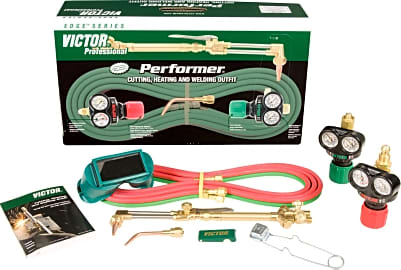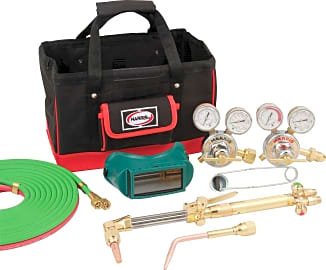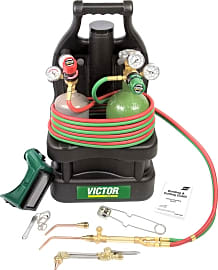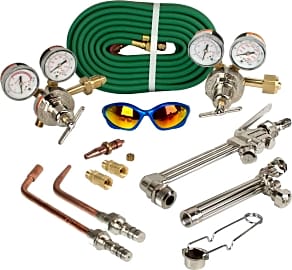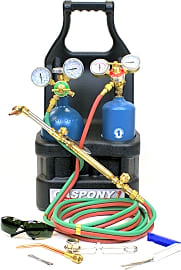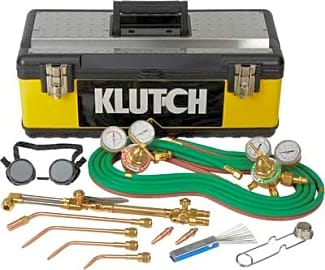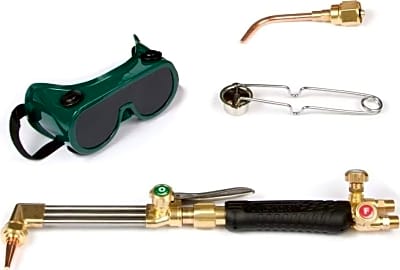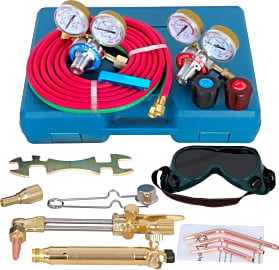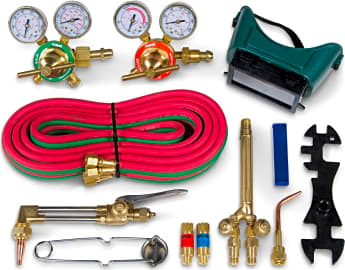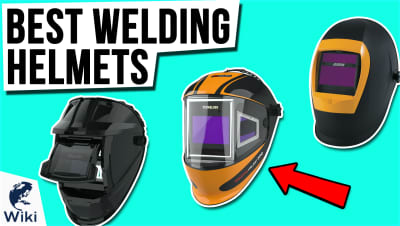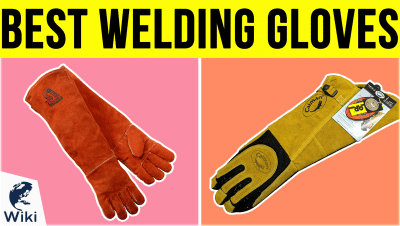The 10 Best Cutting Torch Kits

This wiki has been updated 36 times since it was first published in February of 2016. Oxy-acetylene torches produce extremely hot flames and are capable of cutting and heating a variety of metals. They are versatile, and can be used for welding, brazing, fire polishing, removing seized bolts, and much more. Our selection of high-temperature kits includes multiple styles and designs. Note that these tools are dangerous and should only be used by trained and experienced technicians. When users buy our independently chosen editorial picks, we may earn commissions to help fund the Wiki.
Editor's Notes
December 16, 2020:
While cutting torch technology hasn't changed much for quite some time, we are seeing easier access to consumer grade options. A fair number of these are of questionable quality, and when it comes to such a dangerous piece of equipment, peace of mind that there won't be any leaks or cracks is paramount. That's why you'll see that trusted brands like Victor and Miller continue to fill the majority of the slots on this list. Beyond safety, it's just a matter of the versatility of the attachments and the quality of the peripheral items that also come in the package. Note that, while many come with safety goggles, a full welding helmet as well as protective gloves are highly recommended.
If you're just looking for a new cutting attachment to replace one that's worn out or to have in addition to your oxy-acetylene welding handle, the Victor 411 is going to give you the best quality attachment for the price. That said, the reason it's so cheap is that you aren't getting the hoses or regulators that other packs include. If you're just looking for an inexpensive unit to learn the beginnings of metalwork on, we recommend the Hobart 770502 or the Zeny JA070055. They both come with everything you need to get started and are very reasonably priced. The Victor Technologies 0384-0948 and Thoroughbred TB-GP1 both come with tanks and carts to store them in, which can also be convenient for anyone trying to assemble their first set of equipment.
In terms of high-end consumer models, the Victor Journeyman 2101 replaces the earlier 2036 model. While there aren't a lot of huge changes, it now features the company's newest regulators, which have extra large gauges with clearly labeled pressure ranges and color coded knobs. They're also designed to absorb impacts during a fall, so you don't have to worry about a toppling tank snapping off its regulator and rocketing through your workshop. The regulators on the Victor Technologies Performer use this same technology, so if your top priority is safety, these might be the ones to pick.
July 18, 2019:
Oxy-acetylene torches are an indispensable tool in many industrial settings. Victor and Harris offer many great options for both professionals and amateurs. The Victor Performer and the Harris 4403224 are both great kits that include everything you need to cut, heat, and braze except for tanks and gas. If paired with full-sized tanks, they can be operated for long periods of time.
Full kits like the Victor Technologies 0384-0948 and the Thoroughbred TB-GP1 come with oxygen and acetylene tanks and are great for small jobs. They are inadequate for any medium-duty jobs because the included torches are too small and the gas would only last a few minutes. They can be paired with larger tanks but would still be limited by the size of the torches and regulators.
Oxy-acetylene torches produce intense flames and use high-pressure gas tanks. There are many inherent dangers in using them and so they should only be used by trained professionals to avoid personal injury or damage to equipment.
Special Honors
Uniweld Rollin' Roughneck If you need a rig that can handle heavy-duty projects, is easy to transport, and is built to last, this might be just what you're looking for. The cart is on large, treaded tires, it can be mounted to trucks for safe transport during offsite jobs, and it comes with great safety features, including flashback arrestors and a built-in firewall. All of these features do come at a price though, so it's probably not an ideal kit for hobbyists. uniweld.com
The Vast Power Of Flame
With proper care, they're a safe and straightforward way for skilled metalworkers and artists to manipulate steel and other alloys.
Humans have been using heat to join metal since ancient times. In the Iron Age, metalworkers widely adopted the earliest welding practices. The early forge welders used partially smelted iron ore heated in simple furnaces and then hammered together. In the last century, technology has advanced the field of metalworking just like it has many areas. Now even the home artisan can easily join together a wide range of metals at temperatures reaching thousands of degrees.
Blazing-hot temperatures at one's fingertips have a number of useful applications. A typical oxy-acetylene setup produces a flame as hot as 6,000 degrees Fahrenheit. Military, industrial, and artistic outfits have used these systems for decades, manufacturing durable and expressive pieces. The ability to chemically rip through hardened alloys makes demolition and salvage jobs easy when they might otherwise be impossible. The relative portability of a gas torch lets field operators use these tools in place of bulky angle grinders and welding generators.
Since all they do is burn two gasses, oxy-fuel torches are among the simplest and most versatile tools in the garage. Using the proper tips, they can burn through metal as thick as eight inches or more using pressurized oxidation. With proper care, they're a safe and straightforward way for skilled metalworkers and artists to manipulate steel and other alloys.
What Happens When The Torch Is Lit
A simple blowtorch uses a bottle of pressurized gas and ignites it as it mixes with atmospheric oxygen. That will only get your flame up to around 3,500 degrees. Cutting torches differ in one crucial way. In addition to the pressurized fuel, an additional tank of pressurized oxygen is fed to the nozzle. This allows for the efficient burning of fuel gasses even more volatile than propane.
When cutting metal, the fuel gas is used alone to heat the metal past its ignition point.
The process isn't too complex. Equal-length hoses feed pressurized fuel and oxygen to a nozzle with a pressure regulator. For welding purposes, the fuels burn together in order to bring both metal pieces to the same high temperature. When they're pressed together, the opposing metal molecules diffuse around each other, forming a metallic bond. Under the right conditions, this bond can be even stronger than the individual metals themselves — in poor welds, the bonds are often weaker.
When cutting metal, the fuel gas is used alone to heat the metal past its ignition point. Pressurized oxygen is applied, turning the burning iron into iron oxide. This melts away at half the temperature of iron, leaving a quick and clean incision.
There have been a few different fuels used in cutting torches in the last few decades. Gasoline, propylene, and MAPP Gas have mostly lost favor. Pure hydrogen is a useful fuel, particularly because it works at extremely high pressures and is therefore useful underwater. Because the main byproduct of burning hydrogen and oxygen is water, it's perfect for sensitive processes that require the flame to be free of contaminants.
In addition to underwater (or bariatric) welding, oxyhydrogen is suitable for working with impurity-free laboratory equipment (especially glass components), as well as crafting high-value precious materials or heat-polishing of acrylic glass. However, it can't be used to weld ferrous alloys because residual hydrogen from the oxidation process can make the metal brittle.
The most popular choice for most home and professional users is acetylene, a simple chemical made up of two carbon and two oxygen atoms. It's not cheap, but it burns cleanly, is readily available in most countries, and the vast majority of torch options on the market are designed for it.
Also of important note is propane, usually mixed with butane. It's not ideal for welding, but thanks to its burning tendencies, it's great for heating and can cut faster than other fuels, though usually not as cleanly. Propane is cheaper and easier to transport than acetylene, and a lot of models easily convert to its use.
Isn't All That Heat And Pressure Dangerous?
Not if you're careful. Like many other highly effective tools today, these machines can cause disaster when used carelessly. But proper knowledge, technique, and respect make using these products perfectly safe.
Should you tip one over, simply make sure to store it upright for as long as it was on its side.
Following a few important rules helps keep everyone and their welding equipment from exploding. For starters, the acetylene itself isn't just collected in an empty metal tank. A solid absorbing material such as wood fibers or diatomaceous earth takes up much of the space in these special reservoirs. Because acetylene is extremely volatile under pressure, acetone is used as a solvent medium to safely store the gas in the empty space left in the container.
Because of this relatively complex storage method, acetylene canisters must always remain upright. Should you tip one over, simply make sure to store it upright for as long as it was on its side. This lets you safely use the unit after the fuel mixture settles back to the bottom of the tank.
There's also the matter of the order in which you turn on and off the gas nozzles. Always turn off the oxygen valve first when using an oxy-acetylene setup. This keeps the excess fuel from backfiring into the hose and building up carbon soot or, worse, mixing and igniting fuels inside or outside the supply lines. That could have deadly results. The opposite can be true when using alternate fuel types; harsher fuels are less volatile but can release fumes corrosive to living tissue. Consult your specific model's user manual for the proper order of operations.
Also, most advanced units today employ flashback arrestors to keep gasses in their supply hoses, preventing dangerous combustion. There are a few different styles of arrestors that prevent burnback of volatile fuels and cut off gas sources in the event of increased fuel temperatures or combustion shockwaves.
As long as you follow directions, wear the right goggles, and treat these tools with respect, you can cut and weld like a pro in total safety.


